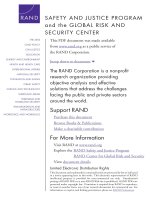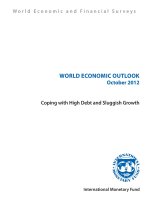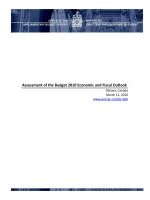global entertainment and media outlook 2012 - 2016
Bạn đang xem bản rút gọn của tài liệu. Xem và tải ngay bản đầy đủ của tài liệu tại đây (3.17 MB, 96 trang )
www.pwc.com/outlook
Global entertainment
and media outlook
2012–2016
Industry overview
13th annual edition
June 2012
Global entertainment
and media outlook
2012–2016
Industry overview
13th annual edition
June 2012
Each year, PwC’s global team of entertainment and media experts
generates unbiased, in-depth forecasts for 13 industry segments.
Incorporating data from 4 principal regions comprising 48
countries and areas around the world, Global entertainment and
media outlook: 2012–2016 combines deep knowledge of local
markets with a truly global perspective—a powerful tool for
understanding critical business issues.
To learn more about the challenges and opportunities ahead for the
entertainment and media industry, please visit pwc.com/e&m
Global entertainment and media outlook: 2012–2016
Prepared and edited by:
PwC firms help organizations and individuals
create the value they are looking for. We are a
network of firms in 158 countries with close to
169,000 people who are committed to delivering
quality in assurance, tax and advisory services.
300 Madison Avenue
New York, NY 10017
+1-646-471-4000
www.pwc.com
Authored by:
Wilkofsky Gruen Associates Inc., a provider of global
research and analysis of the media, entertainment,
and telecommunications industries.
www.wilkofskygruen.com
Outlook editorial board:
For the PwC Entertainment &
Media Practice:
Deborah Bothun, Principal
James DePonte, Partner
Sean DeWinter, Partner
Marcel Fenez, Global Leader, Entertainment & Media
Nick George, Partner
Stefanie Kane, Partner
Alexandra Maclean, Global E&M Marketing Manager
Radhika Nanda, Global E&M Marketing Executive
Pauline Orchard, Global E&M Marketing Leader
Kenneth Sharkey, Partner
Phil Stokes, Partner
Many other professionals from the PwC
Entertainment & Media Practice reviewed
and added local expertise to this publication.
For Wilkofsky Gruen Associates Inc.:
Use of Outlook data
Permission to cite
This document is provided by PwC for general
guidance only and does not constitute the
provision of legal advice, accounting services,
investment advice, or professional consulting
of any kind. The information provided
herein should not be used as a substitute for
consultation with professional tax, accounting,
legal, or other competent advisers. Before
making any decision or taking any action, you
should consult a professional adviser who has
been provided with all pertinent facts relevant
to your particular situation.
No part of this publication may be excerpted,
reproduced, stored in a retrieval system, or
distributed or transmitted in any form or by
any means—including electronic, mechanical,
photocopying, recording, or scanning—without
the prior written permission of PwC.
The information is provided as is, with no
assurance or guarantee of completeness,
accuracy, or timeliness of the information
and without warranty of any kind, express
or implied, including but not limited to
warranties of performance, merchantability,
and fitness for a particular purpose.
Outlook content must not be excerpted, used,
or presented in any portion that would render
it misleading in any manner or that fails to
provide sufficient context.
Without limiting the foregoing,
excerpts from the publication may
be used only for background market
illustration, should not be the sole
source of 2012-2016 information,
and must not form the majority of
sourced information.
© 2012 PwC. All rights reserved. PwC refers to the PwC network and/or one or more of its member
firms, each of which is also a separate legal entity. Please see www.pwc.com/structure for further
details. AT-12-0120
Global entertainment and media outlook is a trademark owned by PricewaterhouseCoopers LLP.
ISBN 978-1-931684-27-9
Global entertainment and media outlook: 2012–2016, Industry overview
ISBN 978-1-931684-25-5
Global entertainment and media outlook: 2012–2016
David Wilkofsky, Partner
Arthur Gruen, Partner
Norman D. Eisenberg, Vice President
2
Requests should be submitted in writing to
Radhika Nanda at
outlining the excerpts you wish to use, along
with a draft copy of the full report that the
excerpts will appear in. Provision of this
information is necessary for every citation
request to enable PwC to assess the context in
which the excerpts are being presented.
PwC | Global entertainment and media outlook: 2012–2016
Contents: Industry overview
Letter from Global Leader, Entertainment & Media . . . . . . . . . . . . . . . . . . . . . . . . . . . . . . 4
PwC Entertainment & Media Practice—country contacts . . . . . . . . . . . . . . . . . . . . . . . . . . 5
Scope and methodology
Scope . . . . . . . . . . . . . . . . . . . . . . . . . . . . . . . . . . . . . . . . . . . . . . . . . . . . . . . . 8
Methodology . . . . . . . . . . . . . . . . . . . . . . . . . . . . . . . . . . . . . . . . . . . . . . . . . . . . 9
Viewpoint
Preface and economic context . . . . . . . . . . . . . . . . . . . . . . . . . . . . . . . . . . . . . . . . . . 18
The end of the digital beginning:
E&M companies reshape and
retool for life in the new normal . . . . . . . . . . . . . . . . . . . . . . . . . . . . . . . . . . . . . . . . . 23
Summaries by segment and region
Global industry summary . . . . . . . . . . . . . . . . . . . . . . . . . . . . . . . . . . . . . . . . . . . . 48
Global market by segment . . . . . . . . . . . . . . . . . . . . . . . . . . . . . . . . . . . . . . . . . . . . 57
Global market by region . . . . . . . . . . . . . . . . . . . . . . . . . . . . . . . . . . . . . . . . . . . . . 63
Index of tables and charts . . . . . . . . . . . . . . . . . . . . 91
This Industry Overview contains a top-line summary of industry data, along with PwC’s
viewpoint about industry trends. It does not approach the depth or granularity of the
full Outlook content, which provides more than 100,000 data points and in-depth
commentary for the 13 segments and 48 countries and areas covered.
For access to full data sets and commentary, visit the online
Outlook at www.pwc.com/outlook
Industry overview
3
Letter from Global Leader, Entertainment & Media
June 2012
To our clients and friends both in and beyond the entertainment and media industry:
Welcome to the 13th annual edition of PwC’s Global entertainment and media outlook, covering the forecast period 2012–2016. Our
forecasts and analyses for this edition focus on 13 major entertainment and media (E&M) industry segments. To reflect the ever-changing
nature of the industry, as well as the continuing growth of digital revenue streams, we continue seeking out new data sources and have
again increased the depth of data across the 48 countries and areas covered in the Outlook. Given those increases in the depth and breadth
of our content, you will now find certain of the data sets in the online Outlook only. I encourage you to get to know the online edition of the
Outlook, which offers significant additional functionality and flexibility for the user of the underlying data and which includes additional
territory-specific content.
During 2011, both advertising spending and, to a lesser extent, consumer/end-user spending grew as overall economic activity and demand
for high-quality content increased. Proliferation in the usage of smart mobile devices has enabled the convenience of consumption of
content anywhere and anytime to become a reality.
In the near term, economic prospects are mixed but should improve and lead to growth in the sector. However, we anticipate that overall
growth in the E&M industry will lag nominal GDP growth due to an ongoing consumption shift to lower-priced digital distribution.
Although rates of growth in China and India show some signs of moderating, those markets—as well as other fast-growing markets in Asia
and Latin America—are the engines of global growth.
The initial uncertainty of digital migration is giving way to a sharper focus on identifying and executing the business models, organizational
structures, and skill sets that will deliver rising future value in the changed environment. Put simply, digital is now established as the new
normal. The relative availability and affordability of fixed and mobile broadband in different markets set the pace of consumer adoption of
digital. And as a consequence, some markets will continue to see differing growth patterns.
Understanding how consumer behavior is changing and interpreting the mass of data that is being gathered about consumer preferences
are becoming core skills and are providing the basis for monetization either directly or through collaboration and partnering with others.
This is just one example of the areas where sources of value are changing.
All of us at PwC continue to stay on top of trends and developments that may impact your business now and in the future, and we look
forward to further sharing our thoughts with you. We appreciate your feedback and ask that you in turn continue telling us what we can do
to make the Outlook more useful to you. For additional clarification on any matters included in the Outlook or if we can be of service to your
business in any way, either contact one of the PwC E&M professionals listed on pages 5 and 6 or visit our Web site (www.pwc.com/e&m) for
details of the contact in your territory.
Finally, we thank you for your support and wish you an exciting and rewarding year ahead.
Sincerely,
Marcel Fenez
Global Leader
Entertainment & Media
4
PwC | Global entertainment and media outlook: 2012–2016
PwC Entertainment & Media Practice—country contacts
Global
Marcel Fenez
Canada
Tracey Jennings
United States
Kenneth Sharkey
Austria
Bernd Hoffman
Belgium
Eddy Dams
Denmark
John Gabriel Sørensen
Finland
Harri Valkonen
France
Matthieu Aubusson de Cavarlay
Germany
Werner Ballhaus
Greece
Dinos Michalatos
Ireland
Paul O’Connor
Italy
Andrea Samaja
Netherlands
Ennel van Eeden
Norway
Eivind Nilsen
Portugal
José Vitorino
Spain
Virginia Arce
Sweden
Nicklas Kullberg
Switzerland
Patrick Balkanyi
United Kingdom
Phil Stokes
Czech Republic
Jiri Moser
Hungary
Manfred Krawietz
Poland
Adam Krason
Romania
John Webster
Russia
Natalia Yakovleva
Turkey
Murat Colakoglu
Eran Iohan
Middle East/North Africa
Fouad Alaeddin
South Africa
Vicky Myburgh
North America
EMEA
Western Europe
Central and Eastern Europe
Middle East/Africa
Israel
†
†Comprises Algeria, Bahrain, Egypt, Jordan, Kuwait, Lebanon, Libya, Morocco, Oman, Qatar, Saudi Arabia, Syria, and the United Arab Emirates.
Industry overview
5
Asia Pacific
Australia
David Wiadrowski
China
Marcel Fenez
Hong Kong
Marcel Fenez
India
Timmy Kandhari
Indonesia
Chrisna Wardhana
Japan
Akihiko Nakamura
Korea
Hum-Seok Park
Malaysia
Neil Proudlove
New Zealand
Keren Blakey
Pakistan
Sohail Hasan
Philippines
Mary Jade T. Roxas
Singapore
Charlotte Hsu
Taiwan
Han Wu
Thailand
Kajornkiet Aroonpirodkul
Vietnam
Ian Lydall
Argentina
Jesús Estevéz
Brazil
Estela Vieira
Chile
Rafael Ruano
Colombia
Diego Henao
Mexico
Luis Roberto Martínez del Barrio
Venezuela
Estela Vieira
Latin America
6
PwC | Global entertainment and media outlook: 2012–2016
Scope and methodology
Scope8
Methodology9
Scope
The Outlook reflects the collective wisdom of our large team of professionals
who work with entertainment and media companies around the world. It is a
unique resource for the industry, offering a five-year outlook for global consumer
spending and advertising revenues, along with insights into the technology,
government, political, and business trends driving those forecasts.
New additions to the 2012
Outlook
There are a number of data breakouts
included in this year’s Outlook that
were not provided in the past. We have
added trade shows to the “Businessto-Business” chapter, and concerts and
music festivals to the “Recorded Music”
chapter, which we renamed “Music.”
Also in “Music,” we are providing data
for unit sales of both physical and
digital recorded music, available in the
online edition. In “Consumer Magazine
Publishing,” we are providing per-issue
unit sales for print circulation and
paid unit sales for digital circulation,
also available in the online edition.
In “Filmed Entertainment,” we are
providing revenue data for electronic
home distribution through pay TV
providers and also for over-the-top
content accessed via the Internet.
Because video-on-demand and pay-perview are major components of electronic
home video distribution, we are now
including those revenue streams in
“Filmed Entertainment.” And because
“Television Subscriptions and License
Fees” focuses principally on distribution,
we shifted to “Filmed Entertainment”
video-on-demand and pay-per-view to
reflect payments for content.
Categories covered
• Internet access spending:
wired and mobile
• Internet advertising:
wired and mobile
• Television subscriptions
and license fees
• Television advertising
• Music
• Filmed entertainment
• Video games
• Radio
• Out-of-home advertising
• Consumer magazine publishing
• Newspaper publishing
• Consumer and educational
book publishing
• Business-to-business
Regions/countries covered
North America
EMEA
Canada
United States
Western Europe
Austria
Belgium
Denmark
Finland
France
Germany
Greece
Ireland
Italy
Netherlands
Norway
Portugal
Spain
Sweden
Switzerland
United Kingdom
Asia Pacific
Central and Eastern Europe
Czech Republic
Hungary
Poland
Romania
Russia
Turkey
Middle East/Africa
Israel
Middle East/North Africa (MENA)†
South Africa
Latin America
Australia
China
Hong Kong
India
Indonesia
Japan
Malaysia
New Zealand
Pakistan
Philippines
Singapore
South Korea
Taiwan
Thailand
Vietnam
Argentina
Brazil
Chile
Colombia
Mexico
Venezuela
†Comprises Algeria, Bahrain, Egypt, Jordan, Kuwait, Lebanon, Libya, Morocco, Oman, Qatar, Saudi Arabia, Syria, and the United Arab Emirates.
8
PwC | Global entertainment and media outlook: 2012–2016
Methodology
How we derive the data
Forecast information
Historical information
Recent trends in industry performance
are analyzed, and the factors underlying
those trends are identified.
Historical information is obtained
principally from confidential and
proprietary sources. In instances when
third-party sources are consulted and
their information is used directly—
from such sources as government
agencies, trade associations, or related
entities that seek to have their data
disseminated in the public domain—
the sources of such information are
explicitly cited. In instances when the
information is used indirectly, as part of
the calculus for the historical data, the
sources are proprietary.
Each year, we look not only at data for
the most recent year but also at the
historical data to determine whether
there have been any revisions and
whether new sources have emerged
that provide a more complete or more
accurate picture of the market. In some
cases, that exercise leads us to revise
historical spending levels and growth
trends from one edition to the next.
The factors considered are economic,
demographic, technological,
institutional, behavioral, and
competitive, as well as certain other
drivers that may affect each of the
entertainment and media markets.
Models are then developed to quantify
the impact of each factor on industry
spending. Next, a forecast scenario for
each causative factor is created, and
the contribution of each factor on a
prospective basis is identified.
Those proprietary mathematical models
and analytic algorithms are applied in
the process to provide an initial array
of prospective values. Our professional
expertise and institutional knowledge
are then brought to bear in a review and
adjustment of those values if required.
The entire process is then examined for
internal consistency and transparency
vis-à-vis prevailing industry wisdom.
Forecasts for 2012–2016 are also
based on analysis of the dynamics of
each segment in each region and on
factors that affect those dynamics. We
provide compound annual growth rates
(CAGRs) that cover the 2012–2016
forecast period. In the calculation of
CAGRs, 2011 is the beginning year, with
five growth years during the forecast
period: 2012, 2013, 2014, 2015,
and 2016. The end year is 2016. The
formula is:
How we report the data
in each chapter
Segment spending consists of
advertising and end-user spending
related directly to entertainment
and media content. Each chapter
introduction begins with a definition of
the spending streams that are included
in that segment. We do not include
spending on hardware or on services
that may be needed to access content.
End-user spending is counted at the
consumer or end-user level, not at the
wholesale level, and includes retail
markups when applicable.
Advertising spending is measured net
of agency commissions in all territories
except the United States and Russia,
where gross advertising is measured to
be consistent with the way advertising
is generally reported.
In addition to annual-spending figures,
we also present data that are measured
at a single point in time, such as TV
subscriptions, Internet subscriptions,
mobile subscriptions, and newspaper
unit circulation. In those instances,
we show annual averages rather than
year-end totals because annual averages
more accurately connect the impact of
these figures to annual spending.
Inflation
Across all chapters, figures are reported
in nominal terms reflecting actual
spending transactions and therefore
include the effects of inflation.
CAGR = 100 * [(Value in 2016/Value
in 2011)1/5 – 1]
Key to symbols used in the tables and charts
p = preliminary
NA = not available
— = no spending that year
Totals in tables and charts may not total arithmetically due to rounding.
Industry overview | Methodology9
Exchange rates
All figures are presented in US dollars
by using the average 2011 exchange
rate held constant for each historical
year and forecast year. This means
the figures reflect industry trends and
are not distorted by fluctuations in
international exchange rates.
The exchange rates used for the
individual countries in each region are
outlined in the following tables.
Exchange rates per US$ (2011 average)
Exchange rates per US$ (2011 average)
Currency
Exchange rate
United States
Dollar
1.0000
Western Europe
Canada
Dollar
0.9888
Currency
Exchange rate
Austria
Euro
0.7188
Belgium
Euro
0.7188
Krone
5.3552
Finland
North America
Euro
0.7188
France
Euro
0.7188
EMEA
Denmark
Exchange rates per US$ (2011 average)
Currency
Exchange rate
Dollar
0.9687
Germany
Euro
0.7188
Yuan (renminbi)
6.4544
Greece
Euro
0.7188
Dollar
7.7839
Ireland
Euro
0.7188
India
Rupee
46.8466
Italy
Euro
0.7188
Indonesia
Rupiah
8,779.0000
Netherlands
Euro
0.7188
Yen
79.7000
Norway
Kroner
5.6008
Ringgit
3.0528
Portugal
Euro
0.7188
Dollar
1.2629
Spain
Euro
0.7188
Rupee
85.6576
Sweden
Krona
6.4873
Philippines
Peso
43.1844
Switzerland
Franc
0.8866
Singapore
Dollar
1.2567
Pound sterling
0.6235
Won
1,105.7300
Dollar
29.2632
Czech Republic
Koruna
17.6870
Thailand
Baht
30.4944
Hungary
Forint
200.6790
Vietnam
Dong
20,453.6000
Zloty
2.9585
New lei
3.0446
Russia
Ruble
29.3303
Turkey
New lira
1.6774
New shekel
3.5603
US dollar
1.0000
Rand
7.2313
Asia Pacific
Australia
China
Hong Kong
Japan
Malaysia
New Zealand
Pakistan
South Korea
Taiwan
United Kingdom
Central and Eastern Europe
Poland
Romania
Exchange rates per US$ (2011 average)
Currency
Exchange rate
Argentina
Peso
4.1213
Brazil
Real
1.6698
Chile
Peso
481.5800
Colombia
Peso
1,827.4900
Mexico
Peso
12.4183
Bolivar fuerte
4.2897
Latin America
Venezuela
10
PwC | Global entertainment and media outlook: 2012–2016
Middle East/Africa
Israel
Middle East/North
Africa (MENA)†
South Africa
†Comprises Algeria, Bahrain, Egypt, Jordan, Kuwait, Lebanon, Libya, Morocco,
Oman, Qatar, Saudi Arabia, Syria, and the United Arab Emirates.
Figures are estimated in US dollars.
Because all figures are shown as actual
spending, with the effects of inflation
included, nominal GDP growth has an
important influence on entertainment
and media spending. The following
tables show historical and projected
growth rates for nominal GDP for the
individual countries in each region.
Nominal GDP growth by country in North America (%)
2007
2008
2009
2010
2011p
2012
2013
2014
2015
2016
2012–16
CAGR
United States
4.9
2.2
–1.7
3.8
4.5
4.0
4.4
5.1
5.2
5.1
4.8
Canada
6.4
4.6
–4.7
4.9
5.0
4.1
4.3
4.7
4.5
4.4
4.4
Total
5.1
2.4
–2.0
3.9
4.6
4.0
4.4
5.1
5.1
5.0
4.7
North America
View data in your local currency. Visit the online Outlook
at www.pwc.com/outlook
Industry overview | Methodology11
Nominal GDP growth by country in EMEA (%)
2007
2008
2009
2010
2011p
2012
2013
2014
2015
2016
2012–16
CAGR
Austria
5.8
4.1
–3.1
3.5
6.0
3.0
2.9
3.4
3.5
3.8
3.3
Belgium
5.3
2.9
–1.6
3.9
5.4
1.7
2.7
3.0
3.2
3.5
2.8
Denmark
3.9
2.7
–4.9
4.4
4.0
2.8
4.0
4.2
4.5
4.3
3.9
Finland
8.5
2.8
–7.3
4.4
6.2
3.6
4.4
4.6
4.8
5.0
4.5
France
4.9
2.7
–2.0
2.0
3.9
1.4
2.6
3.0
2.9
3.5
2.7
Germany
4.6
2.0
–3.4
4.7
4.9
3.7
4.0
3.9
3.5
2.7
3.6
Greece
7.5
4.3
–0.8
–2.0
–2.7
–3.6
–0.4
0.6
1.6
2.7
0.2
Ireland
6.8
–5.0
–11.3
–3.6
2.0
1.3
2.2
2.6
3.2
3.5
2.6
Italy
4.0
1.4
–3.0
2.3
3.3
–0.6
0.9
2.1
2.8
3.1
1.6
Netherlands
5.3
4.8
–4.3
3.1
4.1
2.9
3.4
3.7
3.0
2.5
3.1
Norway
5.2
10.8
–5.4
5.2
3.4
4.0
4.3
4.6
4.8
5.1
4.5
Portugal
5.3
1.9
–2.3
2.7
1.1
–2.1
0.4
1.2
1.7
2.6
0.7
Spain
7.1
3.2
–3.1
1.8
3.7
2.1
2.2
2.3
3.1
3.8
2.7
Sweden
6.2
2.5
–3.6
6.9
7.2
2.9
3.5
4.4
4.2
4.3
3.8
Switzerland
6.2
4.4
–1.6
2.0
2.5
0.7
2.9
3.1
2.9
3.4
2.6
United Kingdom
5.8
2.9
–3.5
4.4
5.8
3.5
4.2
4.2
4.5
4.4
4.2
Western Europe total
5.3
2.7
–3.3
3.2
4.3
2.1
3.0
3.3
3.4
3.5
3.1
Czech Republic
9.7
4.3
–1.7
1.2
4.1
3.7
4.5
4.8
5.7
5.2
4.8
Hungary
6.7
5.7
–2.6
4.1
5.6
5.1
4.6
5.1
5.8
6.3
5.4
Poland
11.0
8.4
5.3
5.1
8.0
5.2
5.8
5.9
6.2
6.1
5.8
Romania
39.1
19.7
–20.1
–1.0
7.8
5.0
5.6
7.0
7.1
7.0
6.3
Russia
22.0
27.0
–5.7
11.1
12.7
9.9
10.1
10.7
10.4
9.8
10.2
Turkey
11.2
12.7
0.2
18.3
12.9
10.2
8.7
9.0
8.7
9.1
9.1
Central and Eastern
Europe total
16.9
17.7
–3.4
10.1
11.0
8.5
8.4
8.9
8.9
8.7
8.7
6.0
5.2
5.9
5.8
8.4
5.3
5.8
5.8
6.0
5.9
5.7
Middle East/North
Africa (MENA)†
14.7
22.0
–11.1
10.4
11.5
9.2
9.5
9.7
10.0
9.8
9.6
South Africa
14.1
13.2
6.1
8.8
8.7
11.6
9.2
9.0
9.2
9.3
9.7
Middle East/
Africa total
13.4
18.2
–6.1
9.5
10.5
9.2
9.0
9.1
9.4
9.3
9.2
7.2
5.8
–3.5
4.7
5.8
3.7
4.4
4.8
5.0
5.0
4.6
EMEA
Western Europe
Central and Eastern Europe
Middle East/Africa
Israel
EMEA total
†Comprises Algeria, Bahrain, Egypt, Jordan, Kuwait, Lebanon, Libya, Morocco, Oman, Qatar, Saudi Arabia, Syria, and the United Arab Emirates.
12
PwC | Global entertainment and media outlook: 2012–2016
Nominal GDP growth by country in Asia Pacific (%)
2007
2008
2009
2010
2011p
2012
2013
2014
2015
2016
2012–16
CAGR
9.2
9.1
0.6
5.5
4.7
6.2
6.2
6.1
5.7
6.0
6.0
19.6
18.1
8.6
16.7
14.9
12.3
12.5
12.8
12.6
12.7
12.6
9.6
3.8
–3.3
7.8
11.8
8.9
8.4
7.6
8.0
8.3
8.2
India
16.1
12.0
17.3
20.3
16.4
14.2
13.8
14.0
13.8
12.7
13.7
Indonesia
18.3
25.3
13.2
14.6
12.5
13.2
12.5
12.7
13.0
13.2
12.9
Asia Pacific
Australia
China
Hong Kong
1.6
–2.0
–6.1
3.2
–0.9
2.0
1.5
1.7
2.1
2.1
1.9
11.8
15.4
–8.3
12.7
8.6
7.7
7.7
7.5
7.5
7.7
7.6
7.9
1.7
1.2
4.0
6.5
6.6
5.7
5.2
5.3
5.6
5.7
Pakistan
13.8
18.1
24.4
15.1
16.9
18.3
17.0
16.2
16.5
16.7
16.9
Philippines
10.2
11.4
3.6
10.9
9.4
9.2
9.1
9.3
9.5
9.7
9.4
Singapore
15.6
2.7
–3.1
17.7
9.2
7.3
6.7
6.5
6.7
6.8
6.8
South Korea
7.3
5.3
3.6
9.3
8.0
6.7
6.6
7.1
7.2
6.8
6.9
Taiwan
1.8
10.5
–2.8
11.9
7.1
6.9
7.0
7.1
7.3
7.6
7.2
Thailand
8.7
6.4
–0.4
11.7
7.6
9.1
9.2
8.6
8.7
8.8
8.9
Vietnam
17.4
29.8
11.7
16.6
25.7
19.2
13.2
13.1
12.9
13.2
14.3
9.1
7.6
2.3
10.8
8.5
8.6
8.6
9.0
9.2
9.4
9.0
Japan
Malaysia
New Zealand
Total
Nominal GDP growth by country in Latin America (%)
Latin America
2007
2008
2009
2010
2011p
2012
2013
2014
2015
2016
2012–16
CAGR
Argentina
24.1
27.8
10.3
25.9
17.8
15.2
14.7
15.0
12.9
12.6
14.1
Brazil
12.3
13.9
5.1
15.4
9.8
9.3
9.4
9.1
8.8
8.7
9.1
Chile
10.3
3.9
2.3
13.8
9.8
7.9
7.7
7.7
7.9
8.0
7.8
Colombia
27.5
17.3
–4.5
24.0
8.4
7.5
7.7
7.7
7.8
7.9
7.7
9.2
7.8
–2.3
10.5
7.3
6.6
6.5
6.9
6.7
6.6
6.7
Venezuela
23.5
37.3
4.8
26.3
29.3
28.7
26.5
26.0
24.9
25.1
26.2
Total
13.6
14.5
2.7
16.4
11.6
11.1
11.2
11.5
11.3
11.6
11.3
Mexico
Industry overview | Methodology13
Global nominal GDP growth (%)
2007
2009
2010
2011p
2012
2013
2014
2015
2016
2012–16
CAGR
7.5
Global
2008
5.8
–1.0
7.1
6.7
5.9
6.3
6.8
7.0
7.1
6.6
The following tables show historical and
projected growth rates for consumer
price inflation for the individual
countries in each region.
Consumer price inflation by country in North America (%)
2007
2008
2009
2010
2011p
2012
2013
2014
2015
2016
2012–16
CAGR
United States
2.9
3.8
–0.4
1.6
2.9
2.0
1.9
2.2
2.3
2.3
2.1
Canada
2.2
2.4
0.3
1.8
2.8
2.1
2.0
2.1
2.0
2.0
2.0
Total
2.8
3.7
–0.3
1.6
2.9
2.0
1.9
2.2
2.3
2.2
2.1
North America
View year-on-year growth for every data line. Visit the online
Outlook at www.pwc.com/outlook
14
PwC | Global entertainment and media outlook: 2012–2016
Consumer price inflation by country in EMEA (%)
2007
2008
2009
2010
2011p
2012
2013
2014
2015
2016
2012–16
CAGR
Austria
2.2
3.1
0.5
1.7
3.1
2.8
2.4
2.3
2.1
2.2
2.4
Belgium
1.8
4.5
–0.1
2.2
3.2
2.0
2.0
2.0
2.1
2.1
2.0
Denmark
1.7
3.4
1.4
2.3
2.5
1.7
2.3
2.2
2.0
1.9
2.0
Finland
2.5
4.1
0.0
1.3
3.4
3.0
2.5
2.3
2.1
2.1
2.4
France
1.5
2.8
0.1
1.7
2.2
1.8
1.6
1.9
1.3
1.9
1.7
Germany
2.3
2.6
0.4
1.2
2.3
2.8
2.5
2.3
1.7
1.3
2.1
Greece
2.9
4.1
1.2
4.7
2.8
1.3
1.2
1.1
1.3
1.4
1.3
Ireland
4.9
4.0
–4.5
–1.6
1.1
2.3
2.5
2.1
2.0
2.1
2.2
Italy
1.7
3.4
0.7
1.6
2.7
0.8
1.5
1.7
1.9
2.0
1.6
Netherlands
1.6
2.4
1.2
0.9
2.3
2.6
2.2
2.1
1.4
0.7
1.8
Norway
0.8
3.7
2.2
2.3
1.6
2.0
2.1
2.3
2.5
2.5
2.3
Portugal
2.8
2.6
–0.8
1.4
3.3
1.3
1.4
1.5
1.6
1.7
1.5
Spain
2.8
4.0
–0.4
2.0
3.1
2.8
2.0
1.4
1.6
1.8
1.9
Sweden
2.2
3.4
–0.3
1.9
2.9
1.8
1.8
2.0
1.9
2.0
1.9
Switzerland
2.6
3.3
–3.9
0.7
0.5
0.1
1.3
1.3
1.4
1.7
1.1
United Kingdom
4.3
4.0
–0.5
3.3
4.8
2.5
2.1
2.0
2.1
2.1
2.2
Western Europe total
2.4
3.3
0.0
1.8
2.8
2.0
2.0
2.0
1.7
1.8
1.9
Czech Republic
3.0
6.4
1.1
1.4
2.0
3.0
2.5
2.4
2.3
2.2
2.5
Hungary
7.9
6.1
4.2
4.9
4.0
4.8
3.4
3.2
3.3
3.0
3.5
Poland
2.3
4.4
3.9
2.7
4.1
2.7
2.6
2.5
2.6
2.6
2.6
Romania
4.9
7.8
5.6
6.1
6.3
3.5
3.2
3.1
3.1
3.5
3.3
Russia
9.0
14.1
11.7
6.9
8.3
6.5
6.4
6.6
6.2
5.7
6.3
Turkey
8.7
10.4
6.3
8.6
5.9
8.3
5.5
5.2
4.6
4.9
5.7
Central and Eastern
Europe total
6.4
9.7
7.9
6.0
6.5
6.0
5.3
5.4
5.0
4.9
5.3
EMEA
Western Europe
Central and Eastern Europe
Middle East/Africa
Israel
0.4
4.7
3.3
2.7
3.4
1.5
1.9
2.0
2.2
2.5
2.0
Middle East/North
Africa (MENA)†
5.7
10.0
3.6
4.6
5.6
5.7
5.5
5.5
5.7
5.9
5.7
South Africa
7.2
11.5
7.1
4.3
5.0
5.5
5.4
5.3
5.4
5.7
5.5
Middle East/
Africa total
5.0
9.5
4.2
4.3
5.2
5.2
5.1
5.2
5.4
5.6
5.3
EMEA total
2.7
4.2
1.4
2.6
3.6
3.1
3.0
3.1
2.9
3.2
3.1
†Comprises Algeria, Bahrain, Egypt, Jordan, Kuwait, Lebanon, Libya, Morocco, Oman, Qatar, Saudi Arabia, Syria, and the United Arab Emirates.
Industry overview | Methodology15
Consumer price inflation by country in Asia Pacific (%)
2007
2008
2009
2010
2011p
2012
2013
2014
2015
2016
2012–16
CAGR
Australia
2.3
4.4
1.8
2.8
3.2
2.8
3.0
2.8
2.6
2.7
2.8
China
4.8
5.9
–0.7
3.3
5.6
3.9
3.9
3.7
3.6
3.8
3.8
Hong Kong
1.9
4.3
0.6
2.4
5.5
4.5
3.5
3.0
2.6
2.7
3.3
India
6.3
8.4
10.9
9.6
9.0
6.5
6.0
5.8
5.5
5.2
5.8
Indonesia
9.1
11.0
2.8
6.9
5.7
6.5
5.4
5.3
5.2
5.0
5.5
Japan
0.1
1.4
–1.4
–0.7
–0.4
–0.1
0.2
0.5
0.6
0.8
0.4
Malaysia
2.0
5.5
0.6
1.7
3.2
2.5
2.4
2.4
2.3
2.2
2.4
New Zealand
2.6
3.8
1.9
1.8
4.4
2.7
2.4
2.4
2.3
2.3
2.4
Pakistan
7.6
20.3
13.6
13.9
13.9
14.0
12.0
10.5
10.0
10.0
11.3
Philippines
2.8
9.3
3.3
4.5
4.5
4.1
4.0
4.0
4.0
4.0
4.0
Singapore
2.1
6.6
0.5
2.8
3.7
2.9
2.4
2.1
2.0
2.0
2.3
South Korea
2.6
4.6
2.8
3.0
4.2
3.2
3.0
2.9
2.9
3.0
3.0
Taiwan
2.3
3.5
–0.9
1.0
1.8
1.8
2.0
2.0
2.1
2.1
2.0
Thailand
2.2
5.4
–0.9
3.3
4.0
4.1
4.2
3.5
3.5
3.4
3.7
Vietnam
8.3
23.1
7.1
8.9
18.8
12.1
6.0
5.5
5.4
5.7
6.9
Total
1.9
3.9
0.2
2.6
4.0
3.4
3.5
3.7
3.6
3.9
3.6
Asia Pacific
Consumer price inflation by country in Latin America (%)
2007
2008
2009
2010
2011p
2012
2013
2014
2015
2016
2012–16
CAGR
Argentina
8.8
8.6
6.3
10.4
10.8
11.8
12.7
11.0
9.0
8.5
10.6
Brazil
3.6
5.6
4.9
5.0
6.4
5.6
5.2
4.7
4.5
4.4
4.9
Chile
4.3
8.8
1.7
1.2
3.1
3.1
3.0
3.0
3.0
3.1
3.0
Colombia
5.6
6.9
4.2
2.3
3.3
2.9
3.1
3.0
3.0
3.0
3.0
Latin America
4.0
Venezuela
Total
5.2
5.3
4.2
3.3
3.4
3.2
3.4
3.3
3.1
3.3
18.8
31.4
28.6
29.1
25.8
24.3
23.9
23.5
22.9
21.1
23.1
4.3
Mexico
6.4
6.2
6.5
7.8
8.6
9.6
10.9
12.1
13.3
10.9
Global consumer price inflation (%)
2007
Global
16
2008
2009
2010
2011p
2012
2013
2014
2015
2016
2012–16
CAGR
2.5
4.0
0.8
2.6
3.8
3.5
3.5
4.0
4.2
4.7
4.0
PwC | Global entertainment and media outlook: 2012–2016
Viewpoint
Preface and economic context
18
The end of the digital beginning:
E&M companies reshape and
retool for life in the new normal
23
Preface and economic context
We are pleased to present the 13th edition of PwC’s Global
entertainment and media outlook.
The purpose of this Industry Overview is to provide a brief overview of
the data presented in the 2012–2016 Outlook and to present a thought
piece on our insights related to the trends that drive the industry and
the growth forecasts.
2011:
The recovery progresses
The global economy began to recover in
2010 from its steep decline in 2009 and
continued to advance in 2011, although
the hoped-for pickup in momentum did
not materialize consistently around the
globe. Global entertainment and media
(E&M) spending rose 4.9 percent in
2011—a bit faster than the 4.5 percent
increase in 2010 but still below gains
in prior expansion years. Advertising
increased 3.6 percent, down from
the 7.0 percent gain in 2010 that was
augmented by advertising associated
with the FIFA World Cup and Winter
Olympics and by the rebound from a
sluggish 2009. Consumer/end-user
spending rose 2.0 percent, up from the
1.3 percent rise in 2010. Internet access
recorded the largest improvement, rising
by 15.1 percent from the 10.0 percent
gain in 2010.
18
PwC | Global entertainment and media outlook: 2012–2016
Projected and actual global 2011 E&M growth by category (%)
Category
Projected
Actual
Advertising
3.1
3.6
Consumer/end user
3.4
2.0
Internet access:
wired and mobile
8.8
15.1
Total
4.3
4.9
Sources: PricewaterhouseCoopers LLP, Wilkofsky Gruen Associates
Projected and actual global 2011 E&M growth by segment (%)
Segment
Projected
Actual
8.8
15.1
Internet advertising:
wired and mobile
13.6
18.7
TV subscriptions and
license fees†
7.0
7.2
TV advertising
3.3
3.1
–5.7
–2.4
Filmed entertainment
5.1
0.1
Video games
6.8
2.2
Consumer magazine
publishing
0.6
–0.8
–0.1
–0.7
Radio
3.1
1.5
Out-of-home advertising
2.0
5.0
Consumer and educational
book publishing
0.7
–1.3
Business-to-business‡‡
0.9
0.6
Total
4.3
4.9
Internet access:
wired and mobile
Recorded music‡
††
Newspaper publishing
†Excludes video-on-demand, pay-per-view, and over-the-top.
‡Excludes concerts and music festivals.
††Excludes video-on-demand and pay-per-view.
‡‡Excludes trade shows.
Industry overview | Preface and economic context
19
In the 2011–15 Outlook, we predicted a 3.1 percent increase in global
advertising, which was a bit lower
than the 3.6 percent actual increase.
Consumer/end-user spending rose
2.0 percent, a somewhat smaller gain
than our 3.4 percent projection. We
expected Internet access spending to
increase by 8.8 percent in 2011, but
actual growth was nearly twice as fast,
with a 15.1 percent increase. A jump
in infrastructure spending combined
with a surge in smart-device penetration fueled large gains in mobile
access and propelled the overall access
market. Overall global E&M growth of
4.9 percent was marginally ahead of
the 4.3 percent increase we projected
last year.
On a segment basis, in addition to
Internet access, Internet advertising,
recorded music, and out-of-home
advertising substantially outperformed
our expectations in 2011, while filmed
entertainment, video games, and
consumer and educational books grew
less than we expected. TV subscriptions and license fees, TV advertising,
and business-to-business materially
matched our forecasts, while consumer
magazine and newspaper publishing
and radio were within two percentage
points of our projections.
In recorded music, declines in physical
spending moderated in a number of
countries, most notably in the United
States, leading to a smaller decline than
we expected and hinting that a natural
Global E&M spending and nominal GDP growth (%)
10
5
0
–5
–10
–15
2007
2008
2009
2010
2011
2012
Global nominal GDP
2014
Global advertising
Global consumer/end user
2013
Global E&M spending
Sources: PricewaterhouseCoopers LLP, Wilkofsky Gruen Associates
20
PwC | Global entertainment and media outlook: 2012–2016
2015
2016
floor may exist in terms of spending
on physical music. In filmed entertainment, box office spending in a number
of countries was disappointing, reflecting less-appealing movies. In home
video, Blu-ray gains were smaller than
expected, while DVDs were pretty much
as anticipated, with the result that
overall physical spending declined. In
video games, growth in online gaming
cut into the console market, leading to
slower growth in overall spending than
we expected. In consumer and educational books, lower-priced electronic
books surged in 2011, cutting into print
sales. Overall spending declined even
as reading picked up.
Looking forward
The economic prospects in the short
term are mixed. Europe’s economy
remains weak, North America appears
to be improving, Latin America is
relatively healthy, and the People’s
Republic of China (PRC) and India
continue to record strong, if moderating, growth. We expect the varied
economic prospects to be reflected in
E&M spending growth in 2012. We
project Europe, Middle East, Africa
(EMEA) to be the slowest-growing
region, with a 3.5 percent increase,
which will be less than the 5.2 percent
advance in 2011. Latin America will
be the fastest-growing region, with a
9.2 percent gain, nearly matching the
9.5 percent gain in 2011. Asia Pacific
will increase by 6.6 percent. Excluding
the relatively sluggish Japanese market,
the remainder of Asia Pacific is expected
to grow by 9.0 percent. North America
will grow by a projected 5.7 percent in
2012, helped by an inflow of electionrelated advertising in the United States
as well as advertising associated with
the Summer Olympics.
Over the longer run, we expect the
economic climate to improve, which
will lead to faster growth in E&M
spending during the next five years
compared with the 2008–11 period.
Nevertheless, we expect E&M growth
to continue to lag nominal GDP growth,
principally because of the ongoing shift
from higher-priced physical distribution
to lower-priced digital distribution. As
the experience of the book publishing
industry in 2011 reveals, the shift in
usage from traditional media to digital
media limits growth because end-user
prices for digital content are generally
lower than prices for physical content.
During the next five years, we project
that E&M spending will grow at a
5.7 percent compound annual rate—
below the projected 6.6 percent compound annual increase in nominal GDP.
E&M spending is affected by the
economy, and countries experiencing
healthy economic growth will see
large gains in E&M spending. By
contrast, weak economies will dampen
growth in other countries. We expect
gains averaging less than 3 percent
annually in Japan, Germany, Ireland,
Denmark, Spain, and Greece and
gains averaging less than 3.5 percent
compounded annually in the UK, Italy,
France, Austria, the Netherlands,
and Switzerland. Full data on E&M
spending by country and major
category can be found in the sections
on regional spending.
The average growth rate masks wide
disparities in growth, resulting from
economic disparities around the world.
A number of countries in Asia and
Latin America along with Middle East/
North Africa (MENA), South Africa,
and Russia will average double-digit
increases during the next five years.
Create customized bar charts and line graphs instantly. Visit the
online Outlook at www.pwc.com/outlook
Industry overview | Preface and economic context
21
The end of the digital beginning:
E&M companies reshape and
retool for life in the new normal
Despite ongoing economic uncertainty, the past year has seen global
sales of tablets and smartphones reach record levels once again—thus
underlining the growing revenue opportunities in the digital delivery
of entertainment and media (E&M) content and advertising to
increasingly connected and, particularly, mobile customers.
However, behind the headlines, an
even more important milestone for the
E&M industry is upcoming: the onset of
the digital new normal. Digital is now
embedded in business as usual. And
as digital moves to the heart of many
media companies and begins to present
the greatest opportunities for growth,
what previously looked like a wide gap
between old media models and new
ones is being bridged.
Companies are planning out and executing their strategies to cross to the new
normal, and with that, we’re hearing
clearer and more-consistent language
from industry CEOs as they articulate
the new landscape. That clearer language signals that the initial uncertainty
triggered by digital migration is giving
way to a sharper focus on identifying,
choosing, and executing the business
models, organizational structures, and
skill sets that will harness new consumer
behaviors to deliver rising future value
in the changed environment.
Digital migration has two main implications for E&M companies: One is
the need to make clear and committed choices about the role or roles
companies should play in the digital
value chain. The other is that behaviors
are changing rapidly and irreversibly
within organizations and organizations’
customer bases—and leaders need to
understand and harness those behavioral changes to grow future revenues.
Three global shifts
Changing consumer behavior is driving
both of the implications. Consumers’
ongoing migration to digital modes of
consumption got accelerated by the economic downturn. And it is now continuing to gain pace during the recovery,
fueled by three forces now commonly
summarized as “social, mobile, and
local,” to which others add, variously,
“global” and “commercial.” Together
those forces will help companies tap
into an expanding pool of value: this
edition of Global entertainment and
media outlook projects that total global
E&M revenues will rise from $1.6 trillion
in 2011 to $2.1 trillion by 2016.
The Outlook also confirms that the
parallel global shifts we’ve highlighted
in recent years will continue to play
out and strengthen through 2016, with
value shifting as follows.
• From print to digital: For example,
electronic books’ share of total global
spending on consumer and educational books will rise from 5 percent
in 2011 to 18 percent in 2016.
• From fixed to mobile-driven consumption: Mobile Internet access
increased from 26 percent of total
Internet access spending in 2007
to 40 percent in 2011—and will
account for 45 percent in 2016.
• From West to East, North to South:
During the next five years, total
E&M revenue growth in the East
(Central and Eastern Europe/Asia
Pacific) will average 7.2 percent
compounded annually, compared
with a 4.3 percent CAGR for the
West (North America/Western
Europe). And growth in the South
(Latin America/Middle East/Africa)
will average 10.0 percent compounded annually—more than twice
the 4.5 percent CAGR in the North
(North America/Europe).
Industry overview | The end of the digital beginning
23
Looking beyond the
impact of digital…
…to map out the industry’s
future topography
In last year’s Industry Overview, we
noted that those shifts—spearheaded
by digital migration—were driving
change in three dimensions: the
empowered consumer, the involved
advertiser, and transformation of
the business for digital. The outcome
of that transformation was a new
type of organization we termed the
Collaborative Digital Enterprise (CDE),
heralding a wider shift to a collaborative ecosystem-based economy.
Against this background, we believe
the reshaping of the industry will take
place based on the perspectives of three
main groups:
The developments of the past year reinforce that view while also underlining
the fact that talking specifically about
“digital” increasingly misses the point.
Digital marketing, for example, now
means marketing in a digital world. And
as digital becomes the new normal, its
rising penetration ceases to be a topic for
discussion. What matters is how companies capitalize on it and operate within it.
24
• For consumers: The creation of
more-compelling, more-immersive,
and increasingly shared experiences
by understanding what connected
consumers want—by finding the
right little data amid the big data.
• For advertisers and value chain
partners: The design of new
business models that reinvent
and expand the value proposition of advertising and content
through innovation.
PwC | Global entertainment and media outlook: 2012–2016
• For the industry: Development of
the right organizational and operational models to understand and
harness new behaviors inside and
outside organizations in order to
grow their revenues and/or margins
in the new normal.
We’ll examine each of those perspectives in turn.









